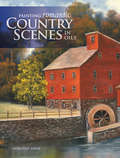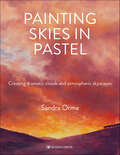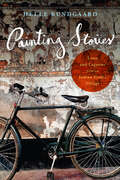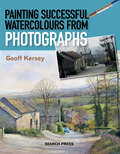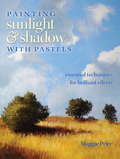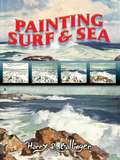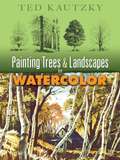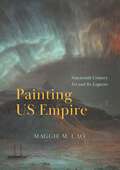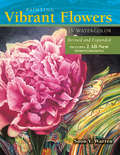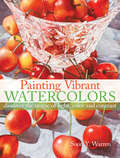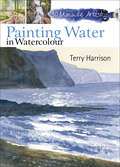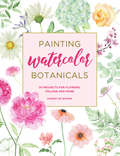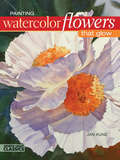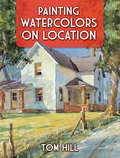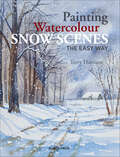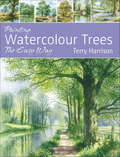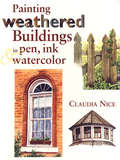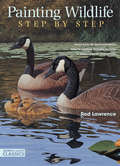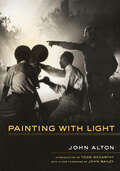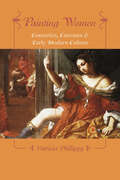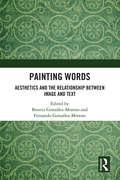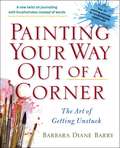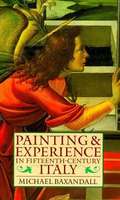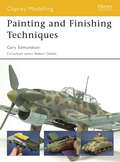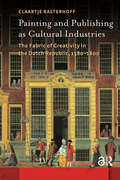- Table View
- List View
Painting Romantic Country Scenes in Oils
by Dorothy DentPaint the charm of country scenesThese tranquil scenes let you create your very own painter's retreat with a luminous sunset, a quiet cottage, a refreshing coastline and peaceful streams meandering past mills. It's easy and fun when you paint along with Dorothy Dent.With 10 step-by-step projects, suitable for both beginners and more accomplished painters, Dorothy shares her easy-to-follow techniques for painting realistic landscapes. Learn how to paint:Rich autumn foliageThe vivid greens of springColorful reflections found in still waterGlowing light from a window on a starry nightSnow-capped mountains created with a palette knifeYou'll also learn valuable principles such as consistent highlights and shadows, how to contrast lights and darks and how to use textures, colors and values. Dorothy shows you exactly how to hold the brush and position the bristles against the canvas so you can make confident brushstrokes. Each painting also features a special Seeing with the Artist's Eye section that teaches you the artistic principles that take a painting from average to extraordinary.
Painting Skies in Pastel: Creating Dramatic Clouds and Atmospheric Skyscapes
by Sandra OrmeThis book will teach beginners and beyond the confidence and skills to create convincing, stunning skyscapes, from rich, glowing sunsets to bright clouds on a fresh, blustery day.This practical and inspiring book distils award-winning artist Sandra Orme's insights and experience into a complete course in the fundamentals of working with pastels. She explores those aspects of colour that are key to painting skies: how to retain vibrancy; how to avoid muddy colours through the use of 'bridging' colours; and how many pastels to use for the best effect. Each of the stage-by-stage projects focuses upon a particular sky effect, and each main stage is shown both before and after blending for clarity. Her 'Sky clinic', which finishes the book, offers more specialist and technical help on some of the common problems readers might encounter.Containing the all-important specifics on how to hold the pastel to make various marks, along with close-up pictures showing how the surface should look before you start to blend at each stage, this book assumes no prior knowledge – and contains information and insights of value to even the most confident artist.
Painting Stories: Lives and Legacies from an Indian Crafts Village
by Helle BundgaardPainting Stories explores the accomplishments, struggles, and livelihoods of traditional artisans in Raghurajpur, a village known for its patta chitra painters. In this collection, Helle Bundgaard weaves thirty years of observations and experiences into a tapestry of stories, which together present a poignant image of the lives of Indian craft makers and their personal connections to the art that they create. The painters’ stories are situated in a rich cultural environment and steeped in social relations. For them, painting is more than a livelihood or an aesthetic expression – it is a way of life. Painting Stories is a window into a part of our world rarely seen, reminding us of both our rich diversity and our shared humanity. Written with the painters, students, and laypersons in mind, the book includes a discussion of ethnographic storytelling and resources for ethnographic writing, as well as color photographs that bring the stories to life.
Painting Successful Watercolours from Photographs
by Geoff KerseyLearn the essential techniques for painting from photographs with this illustrated guide by the acclaimed artist and teacher.Many artists enjoy using photographic reference material, but while there are many advantages to this way of working, there are also unique challenges. One must learn to choose what to leave out, what to keep in, and how to adapt the scene to create a painting. In this book, Geoff Kersey introduces twenty-seven of his own paintings, explaining how they evolved from one or more photographs.Kersey includes photographs, sketches, diagrams, details, colour charts and a wealth of tips explaining his techniques and artistic process. This volume also includes a glossary of painting terms as well as photographs for readers to interpret for themselves.
Painting Sunlight and Shadow with Pastels: Essential Techniques for Brilliant Effects
by Maggie PriceInfuse your paintings with light and life! Whether you work outdoors or indoors, understanding the effects of light and shadow is key to making your art lifelike and engaging. Rather than providing a one-size-fits-all recipe for painting light, this book shows you how to capture the particular ambient qualities of any scene before you, be it a gloriously clear morning, a rainy afternoon, or the joyful dance of sunlight on water. Master pastel artist Maggie Price shares techniques for painting beautiful light, rich shadows and convincing reflections. 10 step-by-step demonstrations tackle a diversity of lighting situations, encompassing various weather conditions and times of day. Five contributing artists explore different styles, approaches and subjects, including landscapes, water scenes and people. Concepts are demonstrated with pastel but are applicable to any medium. An illuminating read for beginning and experienced artists alike, this book will help you engage your viewer by achieving that captivating sense of "being there."
Painting Surf and Sea
by Harry R. BallingerAn award-winning artist and teacher shows how to recapture the beauty and majesty of the sea in this simply written yet authoritative book. Seasoned artists and beginners alike will appreciate its profusely illustrated guidelines, which offer not only step-by-step instructions on depicting seascapes, but also many tips on picture-making in general.Artist Harry R. Ballinger shares insights from his decades of experience with marine painting, clearly explaining the principles on which the sea and surf operate. He combines the basics of composition and color mixing with easy methods for painting surf, sea, skies, sandy beaches, waves, and rocky shores. He also offers invaluable suggestions for choosing everything from the right brush and paint to the appropriate practice subjects. Twelve color and 85 black-and-white illustrations enhance the text.
Painting Trees and Landscapes in Watercolor (Dover Art Instruction Ser.)
by Ted KautzkyJoin noted watercolorist Ted Kautzky as he shares his wisdom on painting the infinitely wonderful details of trees and landscapes. Beginning with the fundamentals of good composition, value arrangement, balance, rhythm, and basic brushstrokes, the book explores ways of painting such important landscape components as trees, roads, puddles, rain, plant life, and fog. Individual chapters are devoted to painting forests, and different types of trees are amply illustrated, from the lush willow to the stately Lombardy poplar. Beautifully presented and filled with valuable insight, this book will be warmly welcomed by art students, landscape architects, commercial artists, and anyone familiar with the author's other popular books.
Painting US Empire: Nineteenth-Century Art and Its Legacies (Abakanowicz Arts and Culture Collection)
by Maggie M. CaoA fresh look at the global dimensions of US painting from the 1850s to 1898. Painting US Empire is the first book to offer a synthetic account of art and US imperialism around the globe in the nineteenth century. In this work, art historian Maggie M. Cao crafts a nuanced portrait of nineteenth-century US painters’ complicity with and resistance to ascendant US imperialism, offering eye-opening readings of canonical works, landscapes of polar expeditions and tropical tourism, still lifes of imported goods, genre paintings, and ethnographic portraiture. Revealing how the US empire was “hidden in plain sight” in the art of this period, Cao examines artists including Frederic Edwin Church and Winslow Homer who championed and expressed ambivalence toward the colonial project. She also tackles the legacy of US imperialism, examining Euro-American painters of the past alongside global artists of the present. Pairing each chapter with reflections on works by contemporary anticolonial artists including Tavares Strachan, Nicholas Galanin, and Yuki Kihara, Cao addresses important contemporary questions around representation, colonialism, and indigeneity. This book foregrounds an underacknowledged topic in the study of nineteenth-century US art and illuminates the ongoing ecological and economic effects of the US empire.
Painting Vibrant Flowers in Watercolor: Revised & Expanded
by Soon Y. WarrenPaint flowers with feeling! You can paint watercolors that capture the beauty and personality of roses, peonies, zinnias and many more brilliant blooms--and achieve color more vivid than you ever dreamed possible with watercolor. In this expanded edition of Soon Y. Warren's best-selling book, she will help you: Capture the unique shapes, textures, details--and temperaments--of magnolias, hibiscus, sunflowers, bougainvillea, gladiolus, dahlias, water lilies and more. Use watercolor to duplicate and enhance the floral colors you see in nature, from subtle to saturated. Create dramatic compositions that excite your viewers. Complement your floral subjects with luscious surrounding textures (antique copper, smooth glass, rich fabric) and flattering backgrounds. Learn fun and easy techniques for underpainting, mingling and texturing with 23 step-by-step demonstrations. Don't be a shrinking violet--express yourself with bold watercolor florals that have as much personality as you do!
Painting Vibrant Watercolors: Discover the Magic of Light, Color and Contrast
by Soon Y. WarrenPaint Watercolors that Shine! Make the most of watercolor's fresh, vibrant nature through light, color and contrast. In the first few chapters, artist Soon Y. Warren helps you lay the groundwork - everything from choosing and lighting subjects to color theory and perspective. Then, follow along with a thrilling series of step-by-step demonstrations to put your ideas into action for paintings that shine!Learn how color, value, contrast and composition affect the impact of your paintingsDiscover the plans and techniques you'll need for successful, realistic watercolorsFollow 16 demonstrations to create brilliant paintingsPaint a variety of subjects, including still life, landscapes, water scenes, flowers, architecture and animalsThis book is the perfect balance of classic theory and hands-on technique. Engaging and easy-to-follow instruction gives you a solid foundation so you can take your work to the next level as you create dynamic paintings.
Painting Water in Watercolour (30 Minute Artist)
by Terry Harrison“From beach scenes to ponds, rivers to seas, puddles and streams, Terry shows how to paint water in all its beautiful painterly effects.” —Karen Platt, yarnsandfabrics.co.ukAll watercolour landscape artists need to know how to paint water, and in this book Terry Harrison excels in demystifying the painting process. Here he shares his expert advice and no-nonsense tips and techniques for producing quick, effective paintings of water. There are two or three-step exercises for painting water in all its varied moods and situations, including ripples, reflections, puddles, streams, breaking waves, choppy water, surf, bridges, riverbeds, boats, and much more. There are then ten step-by-step demonstrations that can be produced in half an hour: a misty lake, track with puddles, ford, waterfall, lazy river, stormy sea, cliffs, fisherman, sunset estuary and fishing boat.Essential painting skills conveyed through quick, lively studiesExpert art tuition from a renowned artist, for beginners, the busy artist, or those wanting to loosen up their painting styleNumerous quick exercises and ten step-by-step demonstrations in a handy, affordable ebook format“Terry demonstrates twenty-three basic exercises to build your confidence with the subject from rippled reflections to crashing waves, fast-flowing streams to sun setting on the sea.” —The Leisure Painter
Painting Watercolor Botanicals: 34 Projects For Flowers, Foliage And More
by Harriet de WintonLearn to create your own beautiful watercolor botanical art with more than 30 projects, as well as information on materials and basic techniques. The graceful, contemporary style of these flowers and foliage is attractive and accessible to all no matter your skill level.
Painting Watercolor Flowers That Glow
by Jan KunzA celebration of light Light has the power to make an ordinary flower extraordinary. Inside, Jan Kunz shares simple, step-by-step techniques for capturing that celebrated "glow" in watercolor. A classic approach to a timeless subject, this encore publication of Kunz's best-selling book covers a fabulous range of inspirations, from lilacs artfully arranged in a sterling vase to daisies skipping along a picket fence. Beautifully illustrated pages feature: * 20 special floral painting techniques * 6 paint-along demonstrations, complete with preliminary drawings * a comparison chart of 21 pigments and their special uses for the flower painter * coverage of everything from selecting materials and arranging flowers, to mixing glazes for radiant effects Kunz explains how composition, color theory and other important elements of painting apply to painting flowers, distilling years of experience into key techniques artists can take straight to their work for sparkling results. It's the perfect pick for artists who want to spend more time at the easel and less time reading about it. www.artistsnetwork.com Ideas. Instruction. Inspiration.
Painting Watercolors on Location
by Tom HillA comprehensive workshop approach presented by a master watercolorist, this guide features 11 step-by-step demonstrations filled with valuable methods and techniques for achieving striking on-site watercolor compositions. Beautiful examples and locations — including the Greek island of Santorini, a desert oasis, and a Midwest farmhouse — provide a wealth of inspiration as author and artist Tom Hill demonstrates how to paint intelligently, selectively edit a scene, and more.Painting Watercolors on Location shows developing artists not only how to acquire better understanding and techniques for painting on location but also how to incorporate these helpful practices into their everyday routines. Suitable for art students and artists at the intermediate level and up, these pointers include suggestions for choosing the correct on-site equipment, rendering accurate drawings, selecting and mixing colors, forming textures, and other methods for creating exciting and expressive watercolor paintings.
Painting Watercolour Snow Scenes the Easy Way
by Terry HarrisonSnow scenes are a popular subject of painters all year round. In this inspiring and accessible guide, best-selling author and popular tutor Terry Harrison shares a wealth of tips and techniques for painting snow in watercolour. Suitable for artists of all abilities, Terry shows you how to capture the beauty of snow-covered landscapes using easy techniques. The book begins with guidance on colour mixes and brushes for achieving different effects, and moves on to step-by-step demonstrations of painting snow-laden trees, frozen streams, wintry skies, falling snow, and the warm glow of a low winter sun. He provides valuable tips on using photographs for reference, and turning a summer landscape into a snow-covered one. There's also a section on how to create a traditional Christmas scene, and how to turn it into a Christmas card. With numerous examples of Terry's beautiful artwork, this book is a truly indispensable guide for anyone wishing to paint snow scenes in watercolour.
Painting Watercolour Trees the Easy Way
by Terry Harrison• Trees are an essential element for any watercolour artist to master, and Terry Harrison provides everything they need to know to paint them the easy way, from simple trees with a few strokes of the brush to fully developed paintings of trees in the landscape. • Eleven beautiful step by step demonstrations and plenty of tips and techniques make painting trees in watercolour achievable. • This book will give confidence to the beginner and will also inspire more experienced artists.
Painting Weathered Buildings in Pen, Ink & Watercolor
by Claudia NiceCapture the Beauty & Charm of Wonderful Weathered Buildings!Paint may fade and iron may rust, but the character of buildings strengthens with age. Join Claudia Nice as she shows you how to portray the mellow hues, weathered wood, cracked windowpanes and other imperfections that make old buildings perfectly wonderful subjects to paint.Using the exciting combination of pen, ink and watercolor, Claudia will help you discover the joy of painting barns, farmhouses, painted ladies, southern mansions and other beautiful classic buildings. Like a treasured artist's journal, this book is filled with art, inspiration and handwritten notes, along with Claudia's friendly, step-by-step instruction.
Painting Wildlife Step by Step: Learn from 50 demonstrations how to capture realistic textures in watercolor, oi l and acrylic
by Rod LawrenceEasy-to-follow, step-by-step demonstrations in acrylic, watercolor and oil Inside, you'll learn how to create realistic wildlife paintings, step by step, mastering dozens of specific wildlife textures, including: Fur of a bobcat, American bison, snow leopard cub and wolf Feathers of a wood duck, white-throated sparrow and northern shoveler Scales of a trout and sunfish Ears of a cottontail rabbit, white-tailed deer and red fox Bills and Muzzles of a northern cardinal, mallard, great blue heron and mountain lion Tails and Feet of a red squirrel, ruffled grouse and blue jay Antlers and Horns of a deer, moose, bighorn sheep and pronghorn White and Black Subjects such as a polar bear, tundra swan and Canada goose Through, you'll benefit from Rod Lawrence's years of wildlife painting experience. He'll help you notice, for example, the way hair and feature textures change on different parts of an animal's body through the seasons - and even according to the age of the animal. Use this heightened awareness, along with the easy-to-follow, step-by-step demonstrations inside, to create more realistic, more sensitive wildlife paintings.
Painting With Light
by John AltonFew cinematographers have had as decisive an impact on the cinematic medium as John Alton. Best known for his highly stylized film noir classics T-Men, He Walked by Night, and The Big Combo, Alton earned a reputation during the 1940s and 1950s as one of Hollywood's consummate craftsmen through his visual signature of crisp shadows and sculpted beams of light. No less renowned for his virtuoso color cinematography and deft appropriation of widescreen and Technicolor, he earned an Academy Award in 1951 for his work on the musical An American in Paris. First published in 1949, Painting With Light remains one of the few truly canonical statements on the art of motion picture photography, an unrivaled historical document on the workings of postwar American cinema. In simple, non-technical language, Alton explains the job of the cinematographer and explores how lighting, camera techniques, and choice of locations determine the visual mood of film. Todd McCarthy's introduction provides an overview of Alton's biography and career and explores the influence of his work on contemporary cinematography and the foreword, written expressly for this edition by award-winning cinematographer John Bailey, explores Alton’s often contentious relationships with colleagues, the American Society of Cinematographers, and the movie industry itself.
Painting Women: Cosmetics, Canvases, and Early Modern Culture
by Patricia PhillippyThis original analysis of the representation and self-representation of women in literature and visual arts revolves around multiple early modern senses of "painting": the creation of visual art in the form of paint on canvas and the use of cosmetics to paint women's bodies. Situating her study in sixteenth- and seventeenth-century Italy, France, and England, Patricia Phillippy brings together three distinct actors: women who paint themselves with cosmetics, women who paint on canvas, and women and men who paint women—either with pigment or with words. Phillippy asserts that early modern attitudes toward painting, cosmetics, and poetry emerge from and respond to a common cultural history. Materially, she connects those who created images of women with pigment to those who applied cosmetics to their own bodies through similar mediums, tools, techniques, and exposure to toxic materials. Discursively, she illuminates historical and social issues such as gender and morality with the nexus of painting, painted women, and women painters.Teasing out the intricate relationships between these activities as carried out by women and their visual and literary representation by women and by men, Phillippy aims to reveal the delineation and transgression of women's creative roles, both artistic and biological. In Painting Women, Phillippy provides a cross-disciplinary study of women as objects and agents of painting.
Painting Words: Aesthetics and the Relationship between Image and Text (Routledge Interdisciplinary Perspectives on Literature)
by Beatriz González-Moreno Fernando González-MorenoPainting Words: Aesthetics and the Relationship between Image and Text addresses the importance of dialogue between art and literature, text and image in our image-saturated era. In a globalized world, isolation and compartmentalization hinder us back, whereas the Romantic idea of belonging urges us to look beyond and to build bridges. Bearing this Romantic spirit in mind, rather than focusing on a traditional paragonal approach, this book puts forward the benefits of alliance by offering an interdisciplinary and transdisciplinary perspective. Illustrations are included to guide the reader into comparativism and intermedial encounters, while providing an inspiring overview of the literary and visual department both in Europe and America from the Renaissance to the twentieth century. The different essays lead us through an aesthetic exploratory journey by the hand of Cervantes, Shakespeare, Felicia Hemans, Emily Eden, William Wordsworth, Edgar A. Poe, Flannery O’Connor, N. Scott Momaday, José Joaquín de Mora, Wallace Stevens and José Ángel Valente, among others. Editors, Beatriz González Moreno and Fernando González Moreno have brought together an international group of scholars around the idea of "painting words," which they define as the pictorial ability of language to stir the reader’s imagination and the way illustrators have "read" literary works over the course of centuries. Many traditional comparative studies examine literature belonging to specific time periods or movements, far less frequently do they bridge visual culture with text-- Painting Words: Aesthetics and the Relationship between Image and Text aims to do just that.
Painting Your Way Out of a Corner
by Barbara Diane BarryIn the tradition of The Artist’s Way , an exciting program that introduces painting as a jumping-off point for realizing one’s full creative potential in all areas of life. Based on author Barbara Diane Barry’s popular course Art for Self-Discovery and supported by research in psychology and the science of brain function, Painting Your Way Out of a Corner guides readers through the process of overcoming blocks and expressing themselves freely in painting. Through a series of exercises that emphasize improvisation and risk-taking, readers will learn how to quiet their inner critics and strengthen their creativity. The more we learn to play and accept whatever appears on the page, the more we are able to try new things in life. Readers will be inspired by Barry’s delightful full-color paintings featured throughout the book. .
Painting and Experience in Fifteenth Century Italy: A primer in the social history of pictorial style
by Michael BaxandallServing as both an introduction to fifteenth-century Italian painting and as a text on how to interpret social history from the style of pictures in a given historical period, this new edition to Baxandall's pre-eminent scholarly volume examines early Renaissance painting, and explains how the style of painting in any society reflects the visual skills and habits that evolve out of daily life.
Painting and Finishing Techniques
by Gary EdmundsonAlthough many modelers can master the basic techniques of construction, it is with the painting and finishing of their kits that many begin to struggle. It is this skill that gives the model its distinctive look and feel and separates the good model form the truly great one. This title will present a detailed, step-by-step approach to addressing the difficulties involved in creating realistic, colorful finishes to armor and aviation models using a variety of different media and techniques. The book swill be aimed at both the beginner and the intermediate modeler looking to improve their skills and, through clear text and photography will give a chapter-by chapter guide to the subject. Each stage will deal with a particular element of the painting and finishing process, whether it be creating camouflage schemes or dealing with markings and decals, to build into a comprehensive study of the subject. Relevant tools and materials will be included in sidebars, whilst a Gallery feature will highlight the range of color schemes and finishes available throughout the world of military and aviation modeling.
Painting and Publishing as Cultural Industries: The Fabric of Creativity in the Dutch Republic, 1580-1800 (Amsterdam Studies in the Dutch Golden Age)
by Claartje RasterhoffThe Dutch Republic was a cultural powerhouse in the modern era, producing lasting masterpieces in painting and publishing, and in the process transforming those fields from modest trades to booming industries. This book asks the question of how such a small nation could become such a major player in those fields. Claartje Rasterhoff shows how industrial organisations played a role in shaping patterns of growth and innovations. As early modern Dutch cultural industries were concentrated geographically, highly networked, and institutionally embedded, they were able to reduce uncertainty in the marketplace and stimulate the commercial and creative potential of painters and publishers-though those successes eventually came up against the limits of a saturated domestic market and an aversion to risk on the part of producers that ultimately brought an end to the boom.
